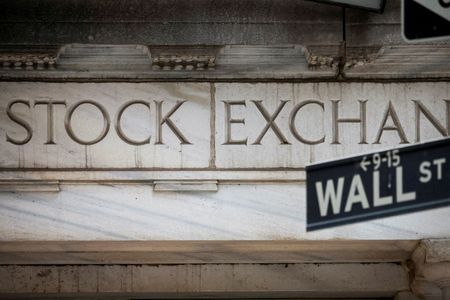By David Randall
NEW YORK (Reuters) – Bruised investors are hoping a so-called Santa Claus rally can soften the pain of a tough year in U.S. stocks and potentially brighten the outlook for 2023.
Without a doubt, the market could use some holiday cheer. In December – typically a strong month for equities – the S&P 500 has so far lost around 6%, weighed down by hefty declines in shares of Tesla Inc, Amazon.com Inc and other names that had led markets higher in previous years. The index is down nearly 20% year-to-date and on track for its worst annual performance since 2008.
History shows the market still has a better-than-average chance to pare those losses. U.S. stocks have risen during the last five trading days of December and the first two days of January about 75% of the time, CFRA Research data showed, a pattern attributed to low liquidity, tax-loss harvesting and investing of year-end bonuses.
Friday is this year’s start date for this rally named after Santa Claus – if it happens. It will only be clear around the second trading day of 2023.
The phenomenon has lifted the S&P 500 an average of 1.3% since 1969, according to the Stock Trader’s Almanac. A December without a Santa rally has been followed by a weaker-than-average year, data from LPL Financial going back to 1950 showed.
The S&P 500 has gained an average of 4.1% in the year after a December without a Santa rally, compared to a 10.9% gain following a period when one takes place. January gains are also muted in a non-Santa year, with the index falling an average of 0.3% compared to a 1.3% gain after a Santa year, the data showed.
“When Santa Claus doesn’t arrive that typically means that there’s something in the market that is causing confusion or an obstacle that it is facing. Negative sentiment doesn’t change because it’s a new year,” said Keith Lerner, co-chief investment officer at Truist Advisory Services.
This month’s steep decline underscores how seasonal trends seem to be offset by worries over whether the Federal Reserve’s monetary tightening will plunge the economy into recession.
The S&P 500 has posted only 18 Decembers with losses since 1950, Truist Advisory Services data showed. The index has gained an average of 1.6% in December, the highest of any month and more than double the average 0.7% gain of all months, according to CFRA data.
This December is shaping up to be one of the exceptions. Investors shed stocks at the highest weekly rate ever in the week to Wednesday, selling a net $41.9 billion, according to a BofA Global Research report on Friday. It attributed the sell-off to “tax loss harvesting,” a strategy that involves selling assets at a loss to offset capital gains taxes.
“The lack of a ‘Santa Claus rally’ this month, with a ‘lump of coal selloff’ in its place, is a troubling sign about 2023 US equity returns,” strategists at DataTrek wrote.
Few economic reports are due next week, with readings on the U.S. housing market and jobless claims, while stock market liquidity is expected to fall near its lowest levels of the year with many on Wall Street off for the holidays.
Much of the market’s trajectory will be dictated by whether inflation can continue to subside and allow the Fed to stop raising interest rates sooner than it has projected.
U.S. consumer spending barely rose in November, while annual inflation increased at its slowest pace in 13 months, but demand is probably not cooling fast enough to discourage the Fed from driving interest rates higher next year.
Other inflation measures have also shown signs of slowing, with consumer prices rising less than expected for a second straight month in November.
“If investors start to see the economy slowing more rapidly than people are anticipating and the Fed ends its rate hikes in the first quarter, we could see a tale of two halves” and a strong positive return next year, said Sam Stovall, chief investment strategist at CFRA.
(Reporting by David Randall; Editing by Ira Iosebashvili and Richard Chang)

